|
The Great Exhibition of 1851 at the
Crystal Palace in London, acted as a ‘wake-up’ call to
many of our industries. The standard of the foreign
exhibits, in particular the French and German products
was much higher than our own, featuring better design,
and superior workmanship, from a higher skilled
workforce. People quickly realised that something had to
be done to re-address the balance, in order for the UK
to successfully compete with our neighbours.
The more progressive industrial towns and cities in the
UK set about correcting the situation by establishing
schools of art and design, to train, and improve the
skills of craftsmen and women. |
|
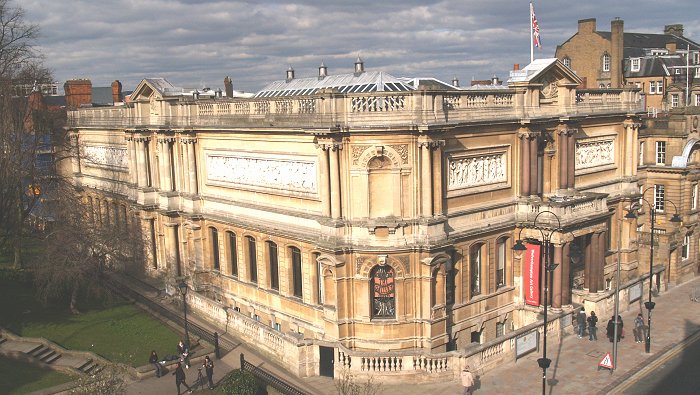
Wolverhampton Art Gallery, as seen from across Lichfield
Street. The side entrance facing St. Peter's Gardens was
the main entrance to the School of Art and Crafts,
which was in the back part of the building to the left
of the entrance. |
|
Wolverhampton was at the forefront
of the movement to establish schools of art and design,
and opened a small school of art and design in Castle
Street, towards the end of 1851.
The art master was Mr. H.
Chittenden, and the honorary secretary was Mr. Charles
Benjamin Mander. The classes were in drawing and
designing. They became extremely popular, and led to the
raising of subscriptions for a much larger,
purpose-built building.
Wolverhampton’s New
School of Art
Land was acquired in Darlington
Street, on the corner of Art Street, for the new
Government School of Practical Art, a handsome
Greek-style, stone-fronted building, the first
purpose-built school of art in the country. The
foundation stone was laid by Lord Hatherton on Tuesday the 21st
June, 1853. The building, designed by Edward Banks, and
built by John Elliot, was completed at a cost of about
£2,300. After the stone laying, a luncheon was provided
for around 300 guests in the Exchange, under the
chairmanship of the mayor, Jeremiah Wynn.
The opening ceremony took place on
the 1st August, 1854, not long after the start of the
Crimean War. Earl Granville who presided, was
supported by Lord Dartmouth, Lord Lyttelton, Lord
Hatherton, Thomas Thorley, M.P., John Neve (mayor), Rev.
J. B. Owen, Rev. William Bevan, George Briscoe, William
Tarratt, John Shaw, George Wallis, H. Chittenden, and
Charles Benjamin Mander. Lord Hatherton was elected,
first president of the school.
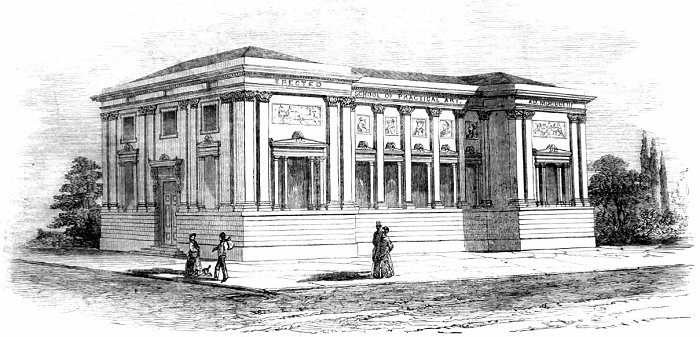
The new art school was
called the School of Practical Art for
Wolverhampton and South Staffordshire.
Courtesy of David Parsons. |
Shortly after the official opening,
Henry Loveridge became chairman, and Charles Benjamin
Mander became honorary secretary. Mr. H. Chittenden soon
retired as headmaster, and was replaced by Mr. J. W.
Muckley, who was later replaced by Mr. Archibald Gunn.
|
|
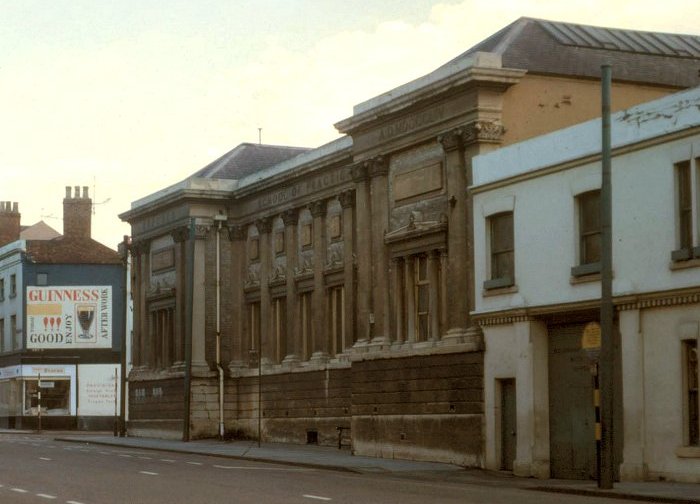
The School of Art in
Darlington Street. Courtesy of Steve Martin. |
|
The north façade faced Darlington
Street, and the entrance was in Art Street on the
eastern side of the building. The entrance led into the
foyer and the staircase. On one side was an 18 feet by
14 feet committee room, with an identical room on the
other side for the headmaster. Beyond the foyer was the
elementary room, 43 feet by 26 feet, followed by the
modelling room, 39 feet by 18 feet. There were also
toilets and cloak rooms. The library, the painting room,
and the antique room were on the first floor, all lit by
skylights. The porter’s flat was in the basement.
The principal staff are listed in
Harrison, Harrod, & Company’s 1861 Directory and
Gazetteer as follows:
President,
Lord Lyttleton; Vice Presidents, George Briscoe, and
Charles Corser; Treasurer and Honorary Secretary,
Charles Benjamin Mander; Headmaster, J. W. Muckley;
Second Master, Edward R. Taylor; School Warden and
Collector, Augustus Ovey.
The classes were well attended, and
the original subscribers continued to support the
school, but within a few years the school began to
struggle financially. The management committee felt that
such an undertaking, which was open to all who chose to
use it, should no longer be a burden on the small number
of subscribers. It should be under the control of the
Corporation, and supported by the local ratepayers. They
felt that if the Free Libraries Act of 1850 was adopted,
a rate might be levied for a free library, and school of
art. In 1860, Councillor Charles Benjamin Mander moved a
resolution at a meeting of the town council, to this
effect, which was accepted. Unfortunately at a
subsequent meeting of ratepayers under the chairmanship
of the mayor, the resolution was violently opposed and
rejected, after a noisy demonstration.
|
|
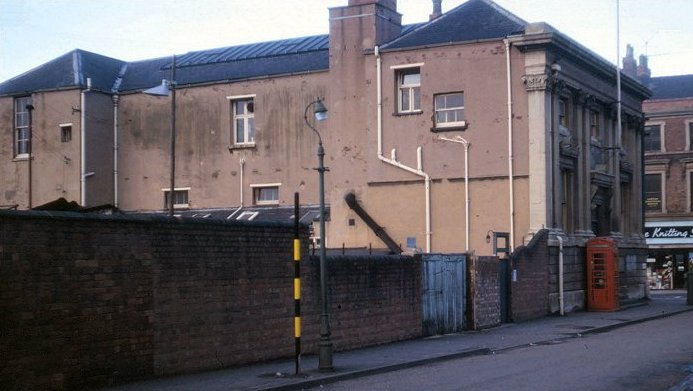
The side and back of
the school, as seen from Art Street. The
main entrance is behind the telephone box.
Courtesy of Steve Martin. |
|
Undaunted, the school managed to
keep going. In 1873 there were 178 students receiving
instruction in art and science. Seven of them gained
Queen’s prizes, eleven gained second class certificates, and a large
number obtained certificates of merit. By this time Mr.
T. Vincent Jackson had been appointed as honorary
secretary of the school.
In 1883 when building work on the
new art gallery in Lichfield Street was underway, the
school’s management committee decided to sell the school
building, and to use the proceeds to move the school
into new premises that would adjoin the art gallery. The
building was then offered for sale. |
|
The Municipal School
of Art and Crafts
For some time it had been
considered that a new school of art, complete with
up-to-date resources, should be built on a site
adjoining the art gallery, and placed under the control
of the Corporation. Such a municipal institution would
greatly benefit the town, but it could not happen unless
the building was paid-for by private individuals.
Luckily, the Art Gallery’s benefactor, Philip Horsman,
bought the Darlington Street premises for £2,000, and
the money was put aside towards the cost of the new
building.
Other benefactors included John and
Joseph Jones, who gave £1,000, Samuel Theodore Mander,
who gave £250, Arthur Briscoe, who gave £300, Henry
Loveridge, who gave £200, and Edward Shaw who also gave
£200. Donations of £100 were received from Captain
Perry, Miss White, and Mr. C. Wells. The project also
received a Government grant of £1,000, which with other
donations made the total up to £5,575.
The land was given by the town
council, and building work rapidly got underway. It was
built as part of the art gallery building by Philip
Horsman & Company, using identical materials. The ground
floor rooms consisted of two rooms for teaching machine
and building construction, one 24 feet by 70 feet, and
another 20 feet square. There were large and small elementary
drawing rooms, around the same size as those already
mentioned, an antique and life room, 24 feet by 47 feet,
a painting room with access to the art gallery, 24 feet
by 32 feet, a light and shade room, the master’s room,
men and women’s cloak rooms and toilets. In the basement
was a modelling and design room, 61 feet by 26 feet. The
building could accommodate between 500 and 600 pupils.
|
|
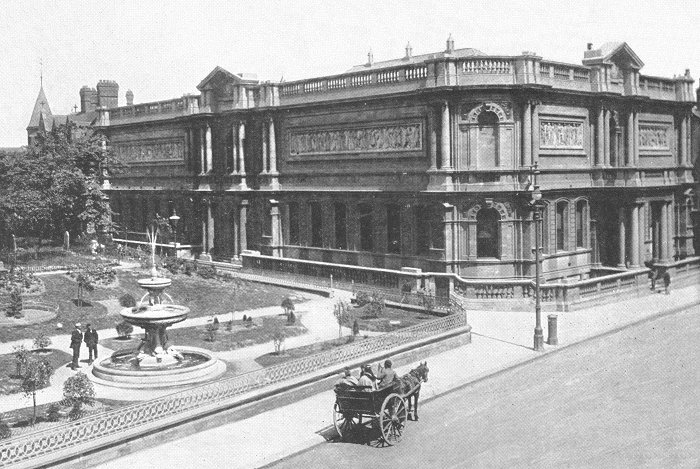
Wolverhampton Art Gallery and
School of Art and Crafts. The school entrance faces St.
Peter's Gardens. |
|
The Municipal School of Art and
Crafts officially opened on 21st June, 1885. A public
reception was held by the mayor, John Annan, with guests
including A. J. Mundella, M.P., President of the Board
of Trade, and William Woodall, Financial Secretary to
the War Office.
Fees were as follows:
|
Students attending
evening classes for craftsmen and
craftswomen - 5 shillings per quarter.
Students attending
higher level evening classes - 7 shillings
and six pence per quarter.
Students attending day
classes - £1.1s.0d. per quarter. |
Mr. Archibald Gunn continued as
Headmaster.
Parts of the Darlington Street
building continued to be used by the school, the
remainder being occupied by the Y.M.C.A.
Student numbers gradually
increased. There were 253 students in 1890, 110 of whom
took examinations. 70 of them passed. In the following
year there were 311 students. 87 out of 174 of them
passed their exams.
|
|
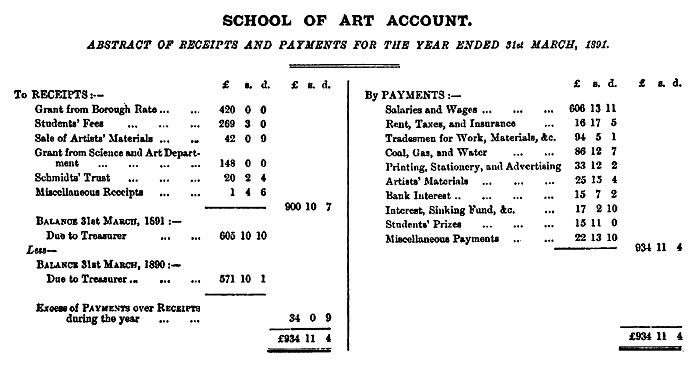
The 1891 accounts. From the
Wolverhampton Red Book. |
|
In 1894 Mr. C. F. Schmidt left £641
in his will to be invested. The interest was to be used
to provide scholarships or prizes in his name. In 1896 a
total of 304 students passed their exams, and a further
23 passed the science exam. At the time there were 383
students. Two silver and three bronze medals were won,
and seven Queen’s prizes were awarded for works sent to
London.
In late 1908 or early 1909 the school acquired the fine
brick-built building at the back, in Wulfruna Street,
now known as the art gallery annexe. It had previously
been occupied by the Wolverhampton Board of Guardians.
The building is listed in the 1908 Wolverhampton Red
Book as being used by the Guardians, but not in the 1909
edition. |
|
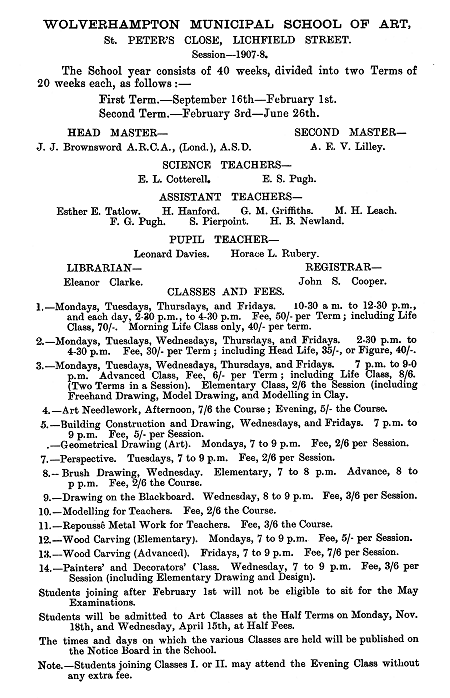
From the 1908 Wolverhampton Red
Book. |
Students included the
internationally known sculptor, Sir Charles Thomas
Wheeler, who studied here from 1907 until 1912.
One of the school’s best known
teachers was Second Master - Robert Jackson Emerson who
taught drawing and sculpture from 1910 until his
retirement in 1942. In 1913 he was elected to the Royal
Society of British Sculptors, and soon became a fellow.
He was also a member of the Birmingham Society of
Artists, and in 1934 was appointed Professor of
Sculpture for the society.
He inspired and taught many
students who later achieved great things. Between 1927
and 1938, four of his students won the Prix de Rome
Scholarship in sculpture. His reputation as a teacher
became almost legendary within the profession, which led
to his election to the Faculty of Sculpture of the Prix
de Rome in 1937.
His most famous student was Sir
Charles Wheeler.
Emerson continued to work after his
retirement despite severe illness. He died in 1944. |
| The Annexe in Wulfruna Street
which was acquired by the school in late 1908 or early
1909. It had been built
in 1887 and was used as offices for the
Wolverhampton Board of Guardians. |
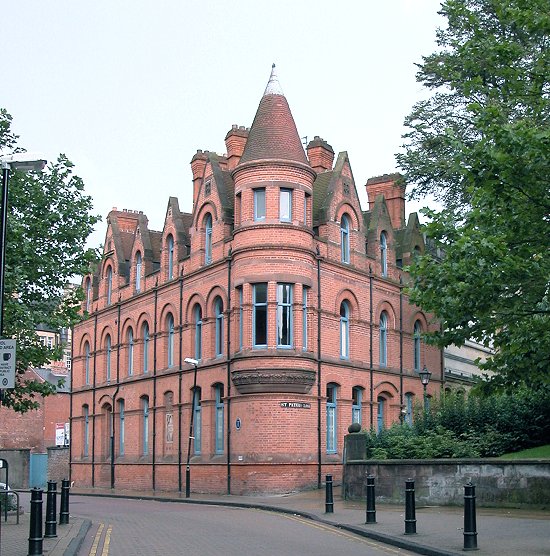 |
 |
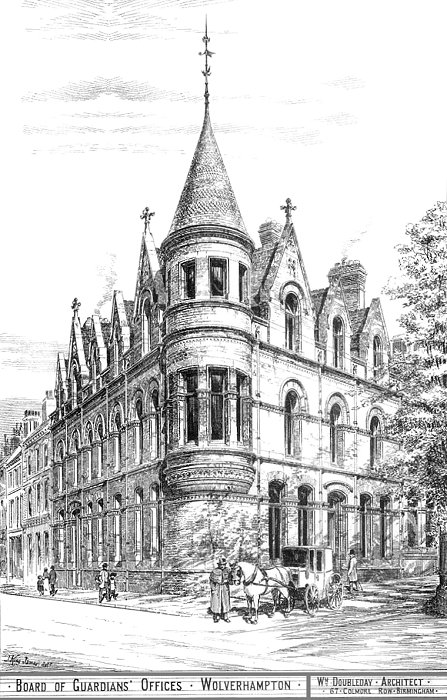 |
|
From The Building News,
24th June, 1887. |
|
|
Modelling classes were offered to
students of the school from the beginning. In 1885 there
were 29 modelling students, 15 of whom sat modelling
examinations. The 1912 syllabus states that the objects
of the School are to effect a complete union between
Arts and Crafts and give a sound practical training in
drawing, painting, modelling, designing, and the crafts,
with a view to the requirements of manufacturers,
designers and craftsmen, and to instruct those who wish
to pursue art as part of their general education, and
also to give facilities for the training of persons who
wish to adopt art as a profession, or to include it in
their qualification as teachers in other Schools.
Elementary subjects included
modelling in clay or cardboard, wood carving, modelling
from the cast and from objects of natural history,
modelling from the antique and from drapery, modelling
the human figure in the round and in relief, modelling
the head from life, modelling hands and feet from
nature, modelling from memory, modelling figure
compositions for sculpture, and lectures on history and
methods of sculpture. Architecture also formed part of
the advanced course. |
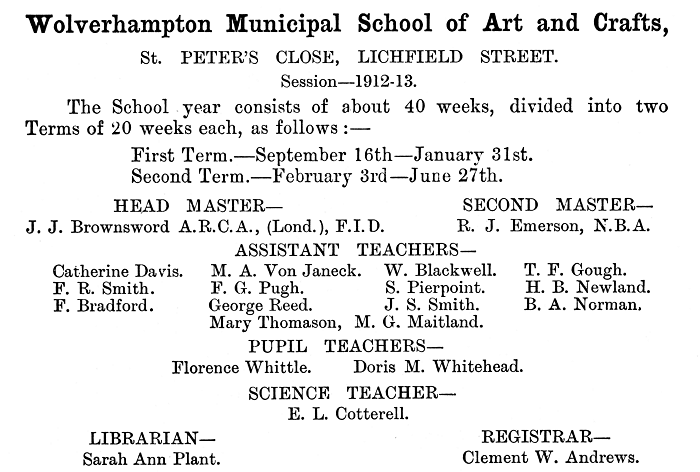
From the 1913 Wolverhampton Red Book.
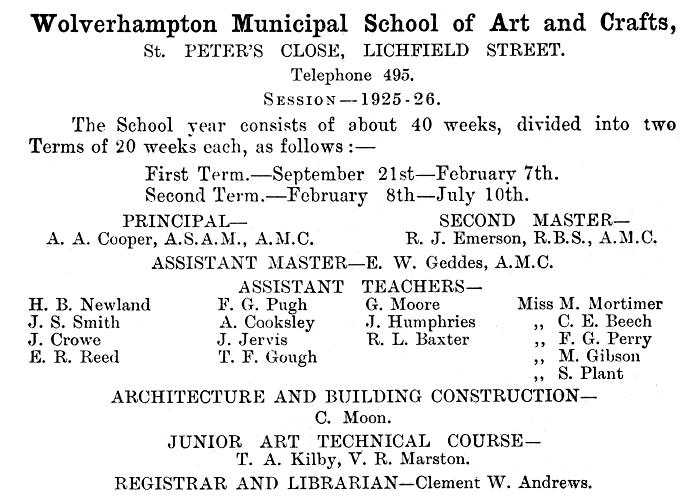
From the 1925 Wolverhampton Red Book.
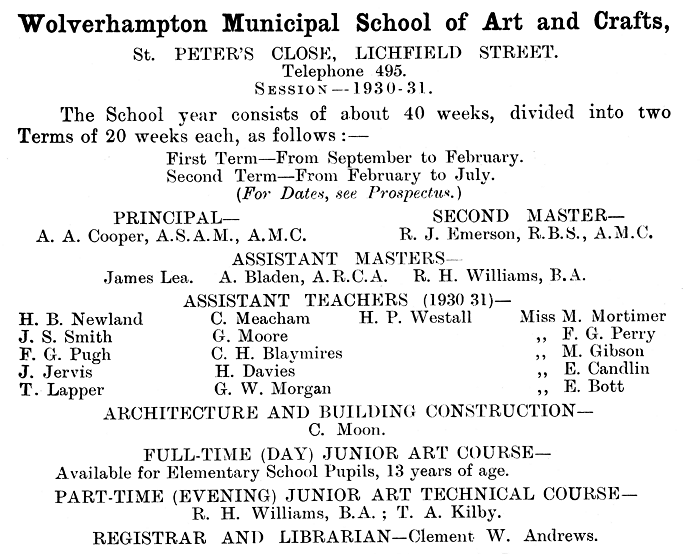
From the 1930 Wolverhampton Red Book.
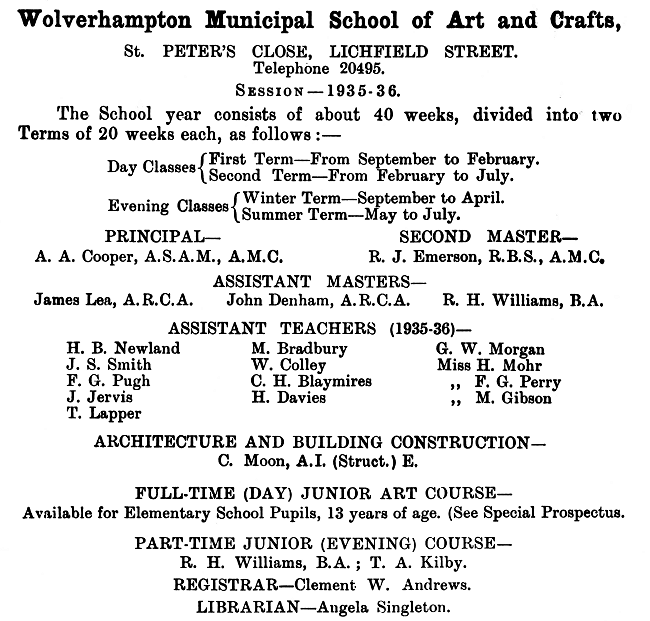
From the 1936 Wolverhampton Red Book.
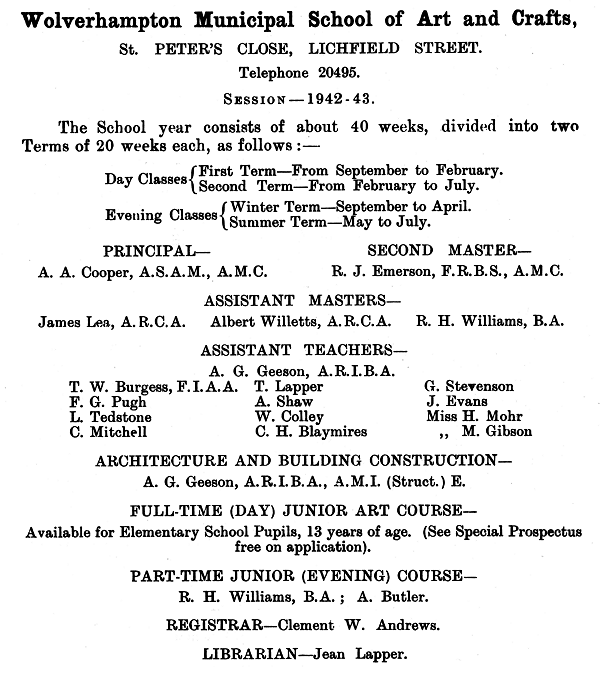
From the 1942 Wolverhampton Red Book.
| Assistant teachers of metalwork
included W. Blackwell who specialised in ornamental
wrought ironwork and ornamental leadwork. Mr. Archibald
Gunn was the school's Headmaster until 1900 when he
retired and was replaced by J. J. Brownsword, who in
turn was replaced by A. A. Cooper. |
 |
|
 |
|
 |
Return to
the
1958 Prospectus |
|
Return to
the contents |
|
Proceed to
Art
College part 2 |
|